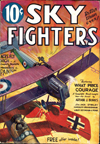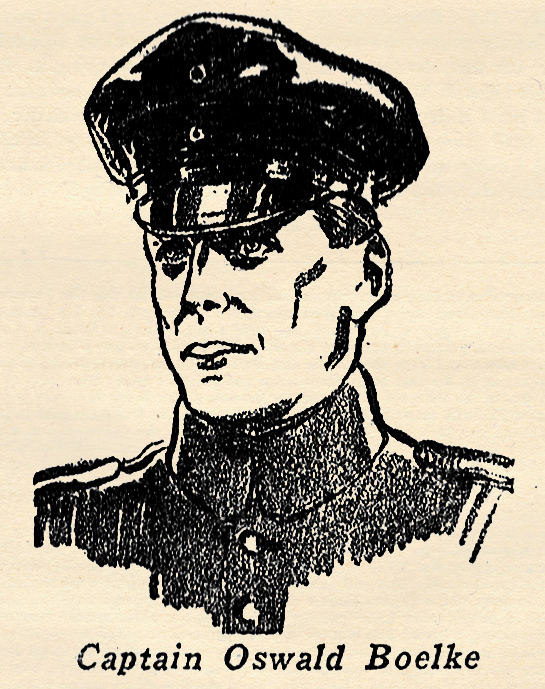“Sky Fighters, November 1933″ by Eugene M. Frandzen
Eugene M. Frandzen painted the covers of Sky Fighters from its first issue in 1932 until he moved on from the pulps in 1939. At this point in the run, the covers were about the planes featured on the cover more than the story depicted. On the November 1933 cover, It’s the S.E.5 vs the Phalz D-3!
THE ships pictured on this month’s  cover are the S.E.5 and the Pfalz D-3.
cover are the S.E.5 and the Pfalz D-3.
The Pfalz was a single-seater chaser manufactured by the Flugzeugwerke firm founded by two famous pioneers of the German aviation industry, the Everbusch Brothers.
Germany built many types of planes during the World War. The Pfalz was one of her outstanding successes. Its motor was a 160 h.p. Mercedes, capable of swinging the plane through the air at 102½ m.p.h. when at a height of 10,000 feet. Low down its 160 horses could pull it along at a slightly increased speed. It was stable laterally, but unstable directionally and longitudinally. It answered to its controls obediently, but always had a tendency to keep turning to the left in flight.

The pilot from his office gets a good view of all that’s going on in all directions except where the top wing interferes with his vision.
The heavy Mercedes made this ship nose-heavy and many an ambitious German pilot got into plenty of trouble in putting his Pfalz into a dive and keeping it there too long. He had a difficult job in yanking the front end of his sky steed into level flight. He also had to watch his step when landing or he was likely to roll up in a ball.
The single-bay “V” struts were probably adopted from the early Nieuport design. The Germans, instead of connecting the lower part of the “V” placed a short member against the lower wing, hoping to get additional strength and to be able to anchor the bracing wires somewhat apart.
Two ships coming together in the air usually means curtains for both. Boelke, the famous German Ace, was killed when his plane was barely grazed by a ship being flown by one of his pupils. Many other airmen have cracked up in this way.
In the picture on the cover it is a toss up whether the Allied pilot will get his ship down safely. His undercarriage has snapped clear of its moorings. If he can keep control of his ship for a split second, he will be able to clear the tail of the German ship and possibly bring his own plane down for a pancake landing. If he can find two trees with a gap between them of about twenty feet he can sheer off his wings and slow up his smash. In the case of the German in his wing-wrecked Pfalz there is not a doubt of his end. He is through.

The S.E.5 single-seater scout (the S.E. stands for Scouting Experimental) was about the smoothest job in its class }hat the British turned out. It was a product of the Royal Aircraft establishment. It was powered by a Hispano-Suiza 220 h.p. motor. It could do around 120 miles an hour. The downward visibility was improved by cutting away a portion of the lower plane close to the body. A Lewis Vickers gun was parked on the left side of the hood in front of the pilot. A Lewis gun was mounted on a track arrangement above the top wing. The pilot was able to pull the butt end of his gun down till he could shoot at a vertical angle at any ship which got above him. This gave him a decided advantage over the single seaters of the enemy’s ships.
The dihedral of the wings was noticeably greater than any other British ship of its time. Landing, the pilot had to be mighty careful, as did the Pfalz pilot in his ship—both ships were nose-heavy.
Major Jimmie McCudden, the British Ace, who downed fifty-three enemy planes before a Spandau bullet carrying his initials snuffed out his glorious career, swore by the S.E.5s. He claimed, as did other of his brother pilots, that it was the finest ship produced during the war. It could hold its own in any maneuver that a Boche ship might force it into and nine times out of ten come out top dog.

Sky Fighters, November 1933 by Eugene M. Frandzen
(The Ships on The Cover Page)
Next time, Mr. Frandzen features the Westland N-17 Seaplane and a German submarine!





 of the flying forces were not on the Allied side. The enemy also had its heroic figures.
of the flying forces were not on the Allied side. The enemy also had its heroic figures.